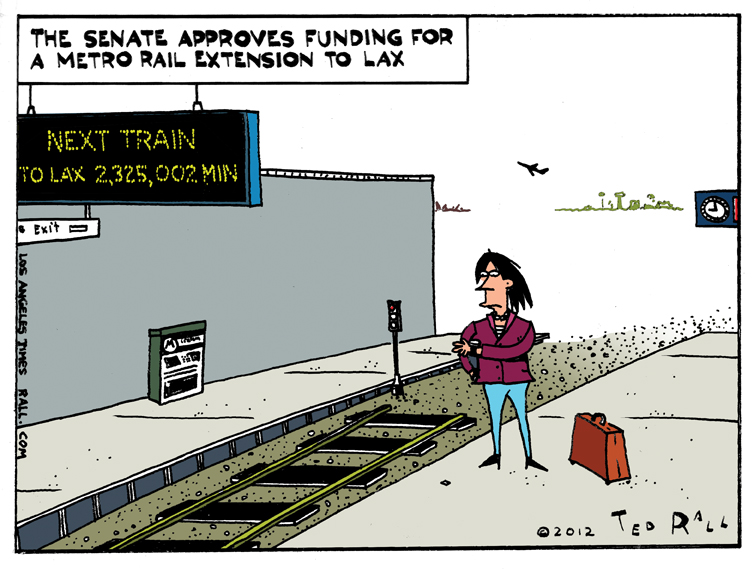Originally published by ANewDomain.net:
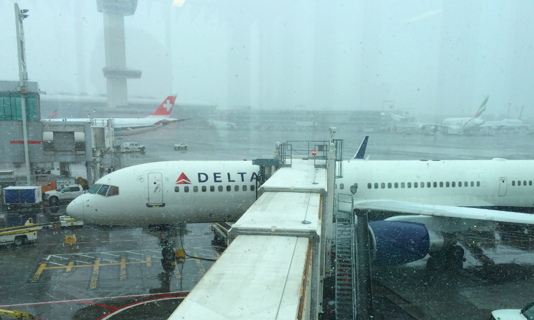 On Friday I traveled from Seattle to New York on Delta. By the standards of American air travel in the year 2015, flight 419 was fine.
On Friday I traveled from Seattle to New York on Delta. By the standards of American air travel in the year 2015, flight 419 was fine.
My seatmates were nice, the woman in front of me didn’t recline her seat until halfway into the flight, the flight attendants were attentive, and we arrived at JFK 45 minutes early – during a snowstorm, no less.
Yet it totally sucked.
The unacceptable state of commercial aviation has become accepted. The insane has been normalized.
It was the best possible terrible experience — one that perfectly exemplified why air travel sucks these days — and everything that’s wrong with the airlines.
Knee Torture
As the guy next to me exclaimed upon sitting down, “They design these seats for midgets!” (It was early, so I didn’t inform him of the more politically correct terms “little people” or “persons of short stature.”) But he’s right: Delta is tied with United Airlines for the dubious distinction of offering the least legroom in coach.
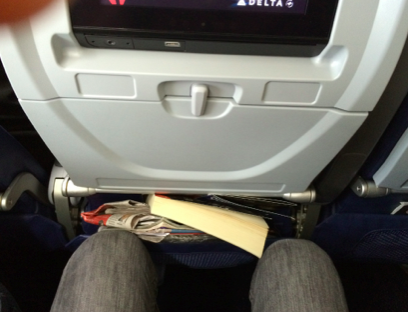
I’m 6’2″. At under 200 pounds, however, I’m a skinny dude. Especially by American standards. I can’t imagine what bigger people do. Or taller ones. Or pregnant ones.
Only the airlines could make me feel sorry for Dick Cheney and Dan Quayle, both of whom have suffered from deep-vein thrombosis associated with flying while stuck in cramped seats. (Don’t those guys get at least business class?)
Check out the photograph above: those are my knees, pressed totally against the seat ahead of me – before the person in front of me opted to recline. (Side rant: reclining should only be enabled on red-eyes.)
You can’t see it here, but my butt is pressed into the corner of my seat; I am sitting straight up. In other words, there is no way to scare an extra millimeter of knee room out of this torture contraption.
I know it could be worse. Someday, probably soon, it will be. A few years ago, you may recall, Ireland-based discount carrier Ryanair flirted with the idea of forcing passengers to stand rather than sit. I also know that the airlines have thin profit margins in a competitive business. However, you’ve got a problem when your customers are driven so crazy that they get into midair brawls over when or if it’s OK to push your seat back.
It’s an even bigger problem when your service is to be endured rather than enjoyed.
Which I might not even have thought about, much less written this piece about, if not for this charming ad on the seat in front of me:
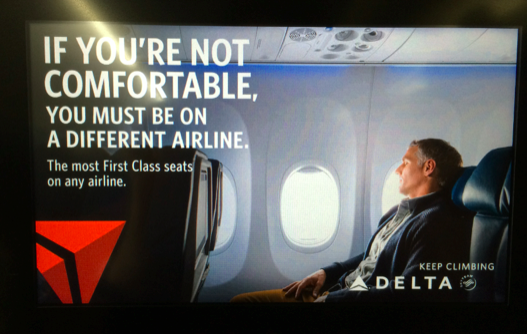
Grim chuckles emanated all around every time this thing cycled through, you know, 14 inches ahead of our faces because – we were definitely not comfortable.
It is hard to overstate how maddening an ad like this is when your knees look and feel like they do in the photo up above. Who’s handling PR for Delta? Howard Schultz of Starbucks? It’s not like we don’t all want to be in first class. It’s not a choice. We’re not riding in coach because we’re cheap.
We’re poor.
Being poor sucks. But you know what’s worse than being poor? Being reminded that other people are rich. Not to mention being told that your poverty is your own damn fault.
Never Saying Sorry
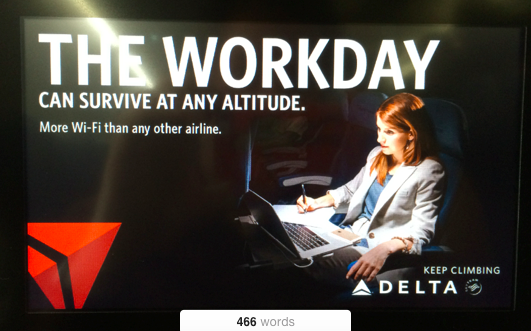 One thing I love about flying is that it can be a great place to get work done, particularly if I get a window seat so no one is trying to get past me to go to the restroom.
One thing I love about flying is that it can be a great place to get work done, particularly if I get a window seat so no one is trying to get past me to go to the restroom.
Unless I can’t.
Friday’s flight would have been a bust the second the woman in front of me reclined her seat into my face; even Houdini couldn’t jam a MacBook Pro between my relatively flat stomach and a reclined seat on Delta. Anyway, it didn’t matter because the Wi-Fi didn’t work.
A five-hour flight is a long time to go without the Internet when you’re a writer, so I’m willing to cough up the outrageously extortionate rate of $33 for GoGo Inflight Internet. Unless, as happened Friday, that wasn’t an option.
As we taxied away from the gate, the pilot helpfully explained that an on-time departure was more important than “the part we would have needed to wait for” in order to get the Wi-Fi working.
Look, I get that stuff happens. Given the fact that it was starting to snow at our destination, I agreed with the pilot’s decision.
What’s annoying is that when the airline inconveniences you – in this case, denying five hours of potential online work time to over 200 passengers – they shrug it off with a glib “oh well.”
When we screw up, we’re expected to pay through the nose. If, for example, you get stuck in traffic and miss your flight, Delta will charge you at least $50 to change your ticket to a later flight the same day. Why can’t I charge them $50 because the Wi-Fi was busted on Friday’s flight? What’s with this unequal relationship?
Foul Food
I never thought I would say this, but I miss the old days of airline food mainly because it was warm.
The war historian John Keegan has remarked that, all things being equal, armies with access to hot food tend to defeat those without it. That’s because the calories and other nutrition inside food is absorbed more effectively when it’s cooked.
I hate the brave new world of airline food, and not only because you have to pay for it à la carte. Morning noon and night, your options are limited to cold lunch: nasty cold cheeses, nasty cold fruits, nasty cold sandwiches. (And Delta’s options are the best of a bad lot.) Give me those old-fashioned mystery – possibly powdered – eggs! Or that plastic tasting ravioli! Just make it warm!
Seasoned travelers like yours truly have learned to work around the dismal state of airline food, or lack thereof, by grabbing a big hot meal on the way to the airport. But there are times, like Friday, when that just isn’t possible.
Think about it, Delta: the flight is at 7 AM. You have to be at the airport at least an hour ahead of time, add a half-hour if you are returning a rental car. At the Seattle Airport, restaurants aren’t open until 6 AM. And the choices are grim.
All I wanted was a light breakfast, maybe a toasted bagel or something ,but that was too much to ask at SeaTac. The guy next to me settled for something called “French Toast Stix.”
Gross.
I would have happily paid $10 or even $15, for some warm powdered eggs.

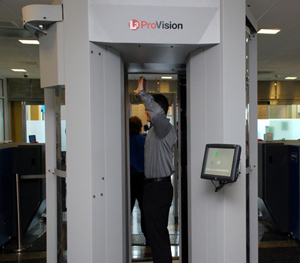 But I’m willing to bet – with my life, and yes, yours, but also those of everyone I love and care about – that eliminating airport security as we know it would be a boon in many ways.
But I’m willing to bet – with my life, and yes, yours, but also those of everyone I love and care about – that eliminating airport security as we know it would be a boon in many ways. 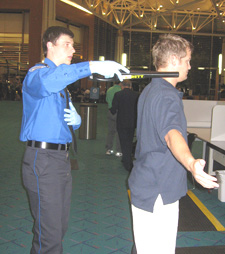 Anyway, it’s not like the current system screens everyone equally.
Anyway, it’s not like the current system screens everyone equally.
